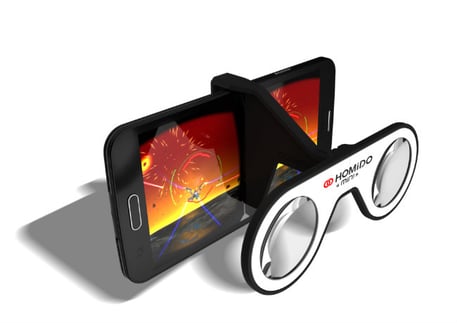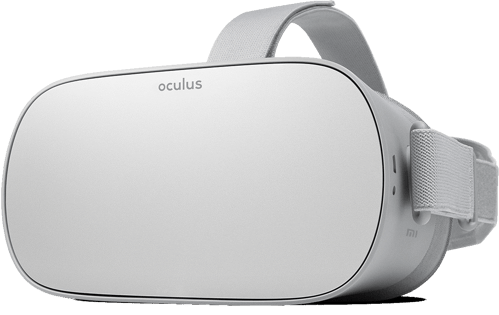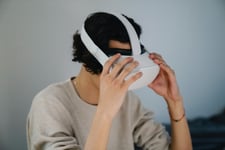Have you purchased a license with a VR platform like Yulio and would like to take VR to your next client-facing meeting? One winning pattern we have observed from sales reps that are currently using VR in their pitches is referring to their VR hardware checklist before heading out. Not only does it give them peace of mind knowing they have everything they need for a successful VR presentation, but it also helps avoid interruptions during their meetings.
One fear that all salespeople in any industry share is whether they have everything they will need for their meeting. Whether it be a larger variety of color swatches or that one configuration that will win them the sale, being underprepared or forgetting products or details can make anyone flustered. With using VR in client-facing meetings, the last thing you want is to experience is the sinking feeling once you remembered you forgot a crucial piece of hardware. And while VR can be a crowd-pleaser, it can quickly have the opposite effect when one part of your presentation is missing.
Today, we’re here to help you get started with creating your very own checklist for using VR in your next client-facing meeting. There is no right or wrong way to build your checklist, but remembering these foundational 3 pieces in your briefcase will ensure you will have all you need during your next meeting.
1. Your Smartphone
While your smartphone is most likely going to travel in your pocket and not your briefcase, however, this piece of hardware is crucial for those who are using mobile VR.
.jpg?width=476&name=kamil-feczko-GLDKA6PYBS4-unsplash%20(1).jpg)
When using VR in business, we highly recommend choosing the mobile route as it allows businesses to be more flexible to have the option to do more with the technology. In regards to using it in sales, mobile VR gives you the mobility to be able to bring the full VR experience to your client. And with the advancement in mobile technology, the majority of smartphones currently available on the market can support virtual and even augmented reality applications. However, unlike a headset, if you’re hoping to use true mobile VR, your smartphone will be one of the two essential items you will need to bring. The smartphone will become the screen your clients will be using to view your VR experience, so remember to bring a fully charged smartphone for your meeting.
A few other considerations to remember is:
- Put your phone on Do Not Disturb or Airplane mode to disable any personal notifications that may pop up during your meeting
- Make sure you have a strong wifi connection in case your platform of choice relies on it
- Pre-load your VR Viewer application and project to be ready to show your clients
- Give your phone a wipe down before heading to your meetings to take away any fingerprints or debris
2. VR Headset
While your smartphone is one half of what you need to bring virtual reality to your client, the other piece of hardware you will need are some VR goggles or a VR headset. However, there are two different types that we will explore.
VR Accessory - Homido Mini

The Homido Mini is our choice for a VR accessory that will be crucial in viewing your VR experience on your smartphone. The key reasons as to why this is our preferred VR goggle of choice is how lightweight, compact, and effective it is. Compared to the Google Cardboard, the Homido Mini’s can easily fit into any bag, and stowing them away is as simple as folding it in half and slipping it back into your briefcase. Plus, we love the intuitive functionality of just clipping on the goggles to your smartphone. Unlike actual VR headsets, the Homido Mini’s allow you to see your client’s facial expressions and reactions to the experience easily. This gives you the opportunity to observe and adapt your pitch to fit how comfortable your client is with the experience.
VR Headset - Oculus Go

The Oculus Go is another mobile VR option to choose from, however, it doesn’t require any other pieces of hardware other than the headset itself. Unlike the smartphone VR experience, the Oculus Go is solely dedicated to providing VR experiences. With its sleek design, the Oculus Go comfortably fits your face to seal off most of the extra ambient light for an even greater immersive experience. So while the Homido Mini + smartphone combo is the most simple and mobile solution, the Oculus Go standalone headset is the solution for you if you value the quality of experience above all else.
Like the considerations we just shared, remember to give your headset enough time to fully charge its battery. Plus, pre-load your VR projects on your headset to lessen any risk of your clients forming a negative experience out of feeling lost in VR.
3. Charging Cables & Bank
While ideally all of your devices will be charged and ready to bring VR in client-facing meetings, the reality is that the battery life of either your smartphone or VR headset could run low throughout the day. Perhaps you will have a full week ahead of you, with back to back meetings throughout the day. If this happens to be the case, we highly recommend investing and bringing a charging bank as well as the necessary cables to keep your devices fully charged.

You can be as prepared as you possibly can be, however, your devices will be of no use to you if they’re out of juice. To combat that, one step you can take in your checklist is to plug in all devices including your charging bank the night before to give them ample time to get to 100%. If you’re constantly on the move, we also recommend bringing a USB adapter, giving you a backup option in case you forgot to keep your charging bank plugged in overnight. As well, the majority of the cars today support USB devices, so you can also consider getting an extra set of your smartphone, VR headset and charging bank cables to keep in your vehicle.
Remember, you can never be underprepared -- especially in the situation of charging.
Build Your VR Hardware Checklist Today
Having a checklist of all the necessary steps or components for bringing VR to your next client-facing meeting will help answer the common salesperson’s fear of forgetting something at home or in the office. Especially if you are new to using VR in your sales pitches, we highly recommend creating and following your own checklist until knowing what you need becomes muscle memory. We hope that with reminding you to bring your smartphone, a VR device/goggle, and charging options will help lay the foundation for your very own checklist. Plus, we highly recommend expanding your checklist to include other steps you need to remember or bringing other items like fabric/color/finish swatches along with you.
Here at Yulio, we strive for excellence in performance and integrity when it comes to our product, and customer service. For a more comprehensive list of questions to ask before deciding on using VR for business, click here to access our Whitepaper. To stay up to date with all things Yulio, follow us on Facebook, Twitter or Linkedin for the latest news and updates in the industry!




.jpg?width=245&height=150&name=active-adult-beautiful-1799244%20(1).jpg)


.jpg?width=245&height=150&name=BUSINESS%20READY%20VR%2076%20(1).jpg)
